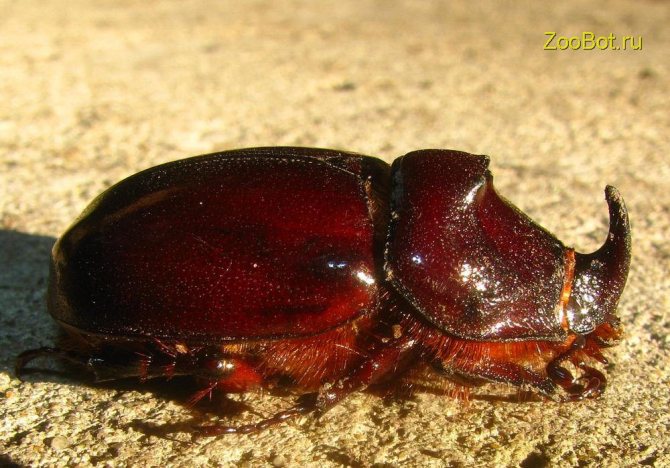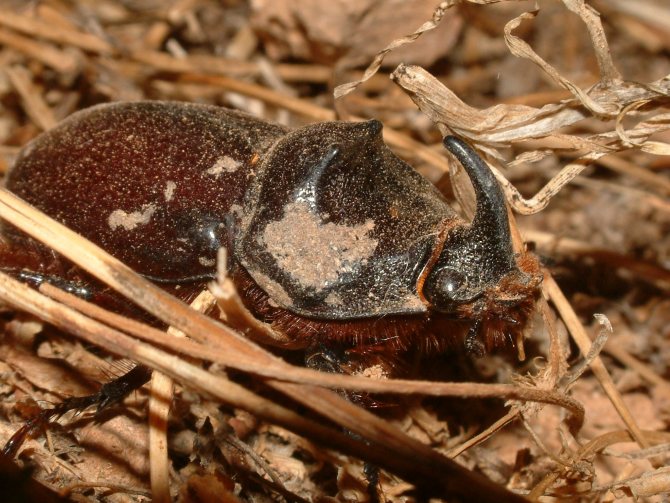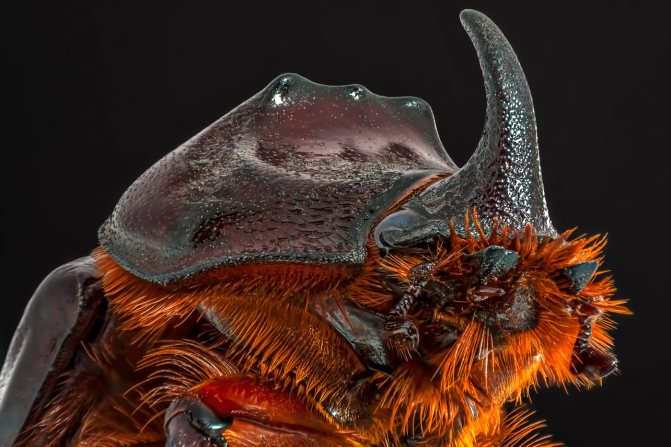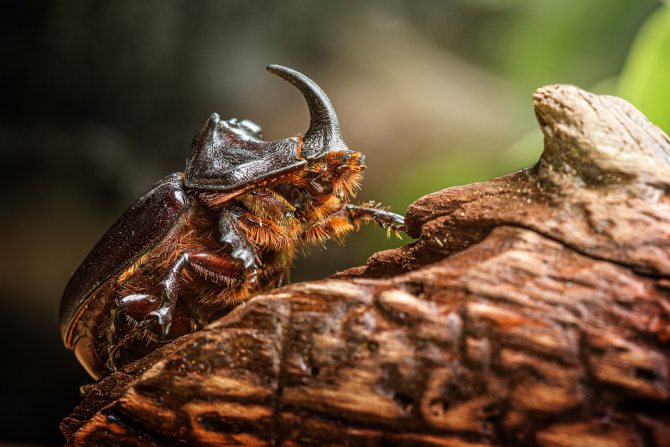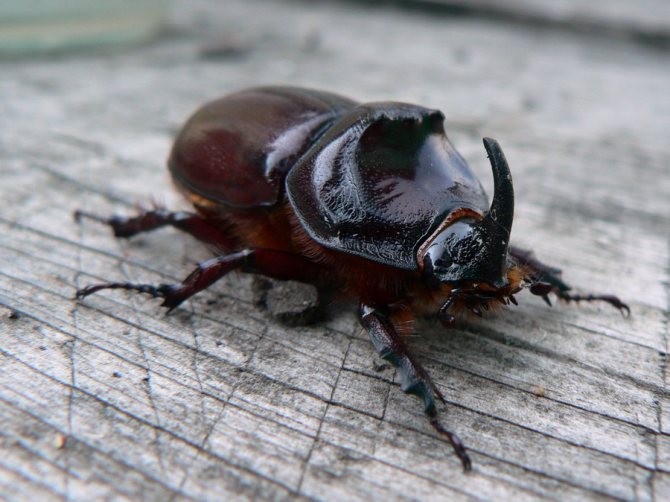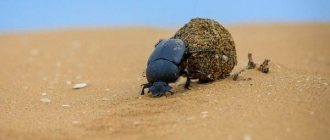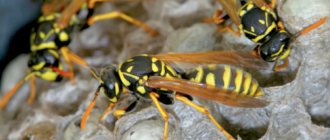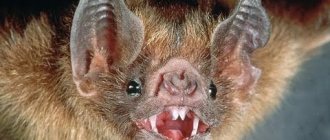An interesting insect that cannot fly according to the laws of physics, but, nevertheless, it does it - the rhino beetle. It has long been the object of painting and creating books. He was portrayed by the artist Georg Gofnagel and he was the hero of the book Konstantin Paustovsky "The Adventures of a Rhino Beetle".
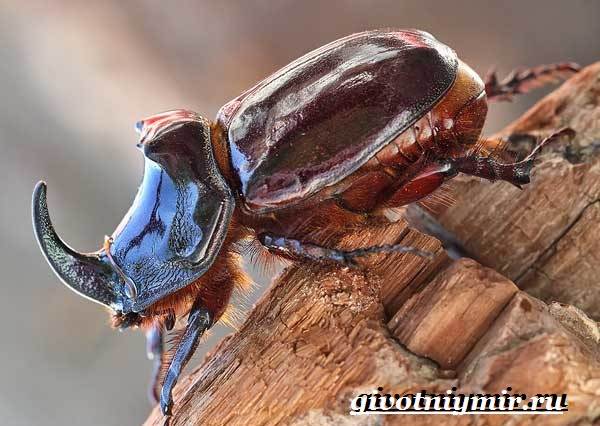
Photo and description of the rhinoceros beetle
The common rhinoceros beetle, or rhinoceros hollow, has large dimensions. In length, males reach from 25 to 47 mm, females are usually shorter by several millimeters. The color of the insect varies from reddish brown to dark reddish brown. The lower surface of the body and the thighs are of a lighter shade with a yellowish tone.
The body is moderately elongated, voluminous and wide, in males it is parallel, in females it has a slight expansion in the posterior direction. The head is small, the first thoracic segment (prothorax) and the elytra have a pronounced shine. The anterior upper part of the head (clypeus) is triangular with almost straight sides, narrowed in the anterior part. In males, it is covered with single dots. In female rhinoceros beetles, they merge into a single spot, and there are rough wrinkles on the clypeus.
Development
The development of rhinoceros beetles is perennial and takes place in rotting organic materialsuch as the aforementioned compost or old sawdust. Like other scarab beetles, the larvae of the insect are typical, similar to the larvae of beetles or dung beetles. During development, the larvae change clothes 3 times, and before the last dressing they measure up to 10 cm... After the 3rd undressing, they turn into a cocoon, from which a beetle emerges after a few weeks. This usually occurs in the fall, but the adult insect remains in the cocoon until the next season.
Habitat: where to find an insect?
The natural habitats of this insect are deciduous forests. Thanks to man, the rhinoceros nest can be found in the artificial plantations of the steppe zone. It also lives in treeless steppe and semi-desert areas. Having turned into an optional synanthropus, he lives next to a person: in greenhouses, greenhouses, manure and compost heaps, deposits of wood waste.
The insect is found in European countries, with the exception of the northern regions and the British Isles. It can be found in the Caucasus and Ciscaucasia, in Southwestern Siberia, Central and Asia Minor, Syria, in northern Africa, and in northeastern Turkey.
The northern border of the beetle's habitat extends from the Baltic Sea to St. Petersburg, capturing the Novgorod and Kirov regions, Yaroslavl, Kostroma, the Republic of Bashkortostan, the southern border - from the mouth of the Urals to the upper reaches of the Embra basin, including the northern coast of the Aral Sea, and further along the steppe regions of Northern Kazakhstan ...
Rarely found in the eastern part. In the southeast, the distribution zone reaches the southwestern part of China and India. In the forest-steppe and steppe zones, the Crimea and the Ciscaucasia, the insect is widespread, in the north of the European zone of the range and in Siberia it practically does not occur.
How to get rid of bugs in the cereal in different ways
If pests are found in cereals or other products, they must be dealt with immediately. The easiest way is to dispose of spoiled food. Pour everything into a bag, tie it tightly and place it in another one of the same.
When the beetles in the croup have become a real problem and are not removed by throwing away the affected products, you have to resort to radical means.
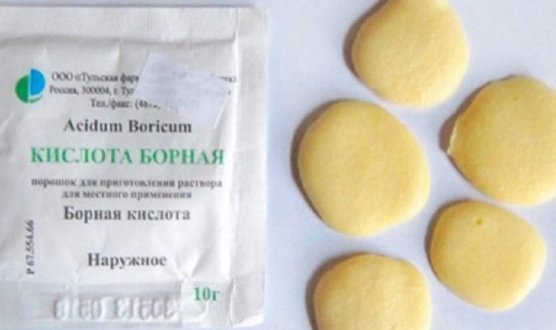

How to make borax or boric acid bait
If insects are wound up in cereals, one folk recipe for homemade bait will help:
You will need borax or boric acid, semolina and powdered sugar. Mix everything in equal amounts. Spread the resulting mixture on all horizontal surfaces
Particular attention should be paid to the place where the pests were found.
The flour-eating beetle dies immediately. Other bugs, larger ones, still run, but will inevitably die. Insects cannot tolerate boric acid, and sweets will attract them to the trap.
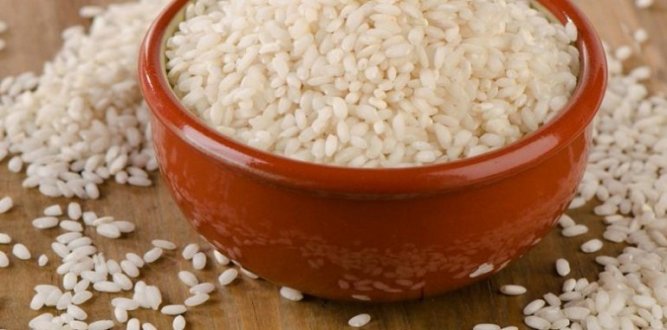

Thermal fight
Small insects do not tolerate sudden changes in temperature, frost and heat. Having found pests in the winter, it is enough to take out the cereals to the balcony. But at the same time, the mercury column should show a mark no higher than -15 ° C. After a couple of hours, all insects will die. This method is especially relevant in order to remove beetles that have taken root in flour or semolina, but at the same time preserve food.
For cereals, the opposite method is suitable - exposure to heat. Pour the food onto a baking sheet and place in the oven. At a temperature of +50 ° C, after 15 minutes, uninvited "residents" will die. But to be sure, it is recommended to hold it for 30 minutes.
Exposure to water and sun
When there is no time or suitable conditions, an alternative option is suitable: take the amount of cereal necessary for cooking and pour hot water over it. This method is suitable for quickly removing most small insects from pasta and bulk food. The pests will float up dead, it is enough to drain them and repeat the procedure.
When there are bugs in the flour, you cannot immediately determine what to do with an ingredient for many dishes. It's a shame to throw away a lot. There is a way out of this situation: you need to take it out into the street. Muco-eaters are afraid of ultraviolet radiation. Under the influence of sunlight, they will run away after 10 minutes. But don't be relaxed. The purified product will not be superfluous to sift twice.
Salt
Washing the cereals with salted water gives a good result. All pests emerge, but after that you need to repeat the procedure with ordinary liquid without impurities. The method is even suitable for oatmeal, but you need to cook it right away.


Table vinegar
Used for wet cleaning after getting rid of insects. The pungent smell of the substance will protect against new pests and drive away those remaining after the persecution. The surfaces are treated with a solution of laundry soap, vinegar essence and boiling water.
Pungent odors
All insects are afraid of strong odors. They are not able to destroy pests, but they will drive them away for a while. Garlic, bay leaves, dry lavender, wormwood and sage can do this. Grasses are laid out after thorough wet cleaning in the former habitats of bugs.


The lifestyle of the rhinoceros beetle: how does it reproduce, what does it eat, how long does it live?
Insects breed during the warm season. Eggs are laid in places where decomposition processes are actively taking place: rotten stumps, dead tree trunks and hollows, rotted manure and compost heaps, etc. In the wild, rhinoceros beetle larvae develop mainly in the root part or root of old trees. Females never lay in citrus and coniferous woody plants. The average duration of this phase is about 30 days.
The birth of larvae occurs mainly in the summer months. By the end of the larval stage, future insects reach 80 to 110 mm in length. In this phase of the life cycle, the beetle larvae are yellow-white, C-shaped, and slightly hairy. They feed on the interior of trees and detritus. Also, the larvae are able to gnaw the roots of living trees.
This development cycle, during which wintering occurs, depends on the climate and latitude of the area. It lasts on average from 2 to 4 years. Pupation occurs in the spring. The pupa is born in a cradle - a chamber with walls formed by wood dust, soil and waste products of larvae. The average duration of this phase is 30 days. Imagoes do not leave the cradle for some time.
Scientists still cannot come to a consensus regarding the nutrition of rhinoceros. The specific structure of their mouth organs makes it possible to make the assumption that they eat soft or liquid food, for example, the juice that is secreted from trees.
There is an opinion that these insects do not need food, but they live off the nutrients accumulated during the larval phase of development.
The flight period of these insects depends on the area where they live. As a rule, they fly from spring to mid-summer, less often to early autumn. How long do these beetles live? In the adult stage, their average life span is about 1–2, but not more than 3 months. This is exactly how much time nature allowed them to leave behind offspring.
Reproduction
The beetle lays its eggs in rotten tree stumps and remains, dung heaps or other places rich in decaying plant organic matter, where the larvae develop. The larvae hatch after about a month.


Phases and duration of development:
- Egg (about a month)
- Larva (lasts 2-4 years)
- Pupa (approximately 1 month old)
- Beetle (about 3 months old)
Thus, he spends most of his life in the stage larvae, but actually in the beetle stage - only one summer.
Interesting facts about the horned beetle


Interesting Rhinoceros Facts:
- The insect is capable of moving objects that weigh 800-1000 times their own weight.
- Contrary to the laws of physics and aerodynamics, these creatures, which have a body that is not designed for flight, can not only fly, but also travel long distances through the air.
- Rhinoceros are capable of generating a small electrical charge. Due to this ability, when colliding with them, other insects can feel a slight current discharge.
- The number of these beetles is rapidly decreasing, and therefore they are listed in the Red Book in many countries.
- Sensing danger, these insects pretend to be dead.
- The color of the beetles depends on their size. The larger the individual, the more richly colored its body.
- In Japan, it is one of the most revered insect species. The Japanese even keep these beetles as pets.
- Since 1943, important studies of these insects by entomologists have been classified and not published in open sources.
- Scientists have not come to a consensus as to why rhinoceros need a horn.
What are the bugs in cereals
The most common types of parasites in the kitchen have different names, but they do the same harm.
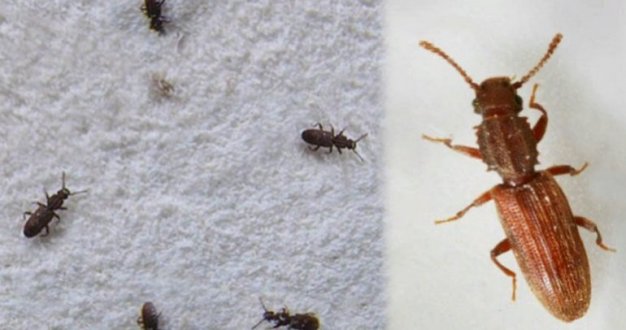

Flour bugs: photo
The red-haired Surinamese muco-eater has a brown color. The adult grows up to 2 mm in size. In addition to processed grain products, concentrates, biscuits and some cereals are preferred in their daily menu. That is why you have to look everywhere.
Insects multiply quickly and it is impossible to find their clutches with the naked eye. Therefore, it is recommended to get rid of the product in which flour eaters have been seen.
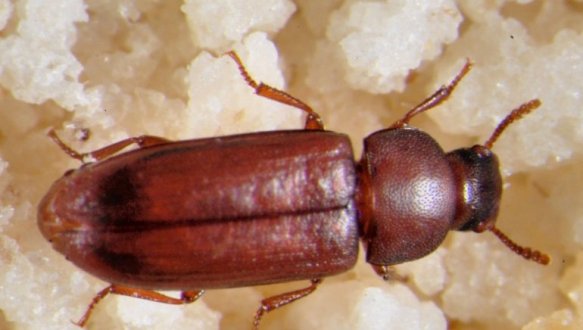

Small beetles
The red-brown flour beetle with small antennae and wings cannot fly. Body length up to 3 mm. A relatively unhurried rate of reproduction is noted - 4 broods per year. Most of all he loves flour, rice, semolina, buckwheat, millet and Artek waffles.
The colony lives close to food supplies. As a rule, he lives in furniture, dishes.
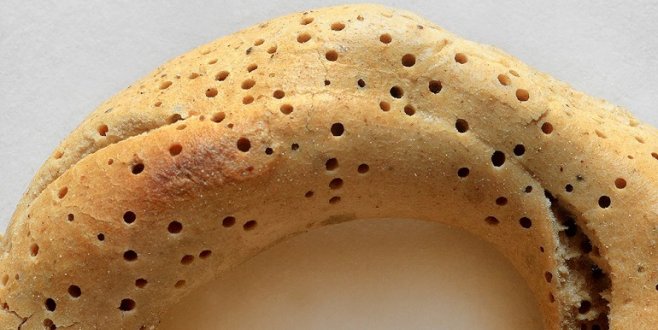

Bread grinders
Insects are cylindrical in shape with a light brown or brown color. They reach 3-3.5 mm in length and are covered with short hairs.The only way to find them in the house is to find them dead on the windowsill. Traces of vital activity are found in books, furniture and on shelves. They eat any nuts, cereals, grains, dried fruits and even plants.


Food moth
It differs from other members of its species, which prefer woolen products, in that it feeds on cereals and dried fruits. A kind of vegetarian moth.
In size it reaches a maximum of 1 cm, looks like a large midge and is distinguished by enviable fertility - in 2 weeks it lays up to 500 eggs. Eats food with incredible speed, flies and disguises itself.
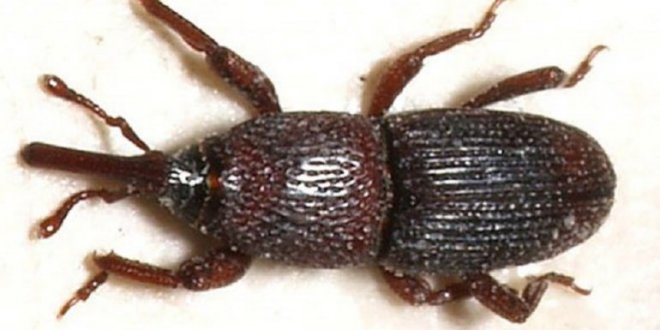

Weevils
Universal pests that eat not only bulk, dry foods and flour products, but also fresh fruits and vegetables. Black beetles grow up to 5 mm long and have a prominent proboscis. Move freely along the walls and fly. They live in containers with provisions, in the corners of closed furniture, less often in bedding.
Southern barn moths
At first glance, they resemble a brown moth, but feed mainly on walnuts, chocolate and dried fruits
If there are a large number of dried apples, these pests turn their attention to them first. Fruit slices turn into silk-wrapped dry lumps with an unpleasant odor
When looking for fireflies, you should pay attention to the ceilings of cabinets or rooms. After the birth of the caterpillar, it is in such places that they prefer to pupate.
Can there be cockroaches in the rump
These most popular and obsessive pests also feed on free-flowing dry foods. But they usually start in a house differently than, for example, flour beetles or grain grinders. They are predominantly scavengers and feed on food waste, living near sinks, urns and cutting tables.


Do rhinoceros beetles bite, are they harmful or useful?
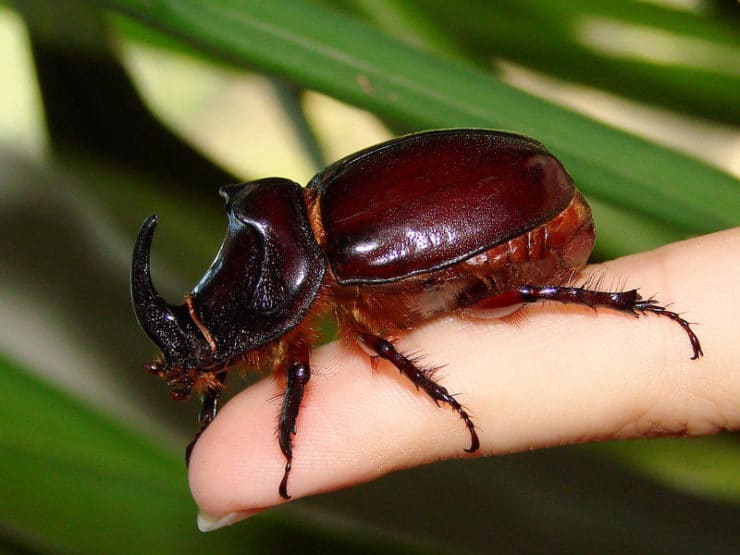

These are amazingly peaceful creatures. They never attack, therefore they are not able to harm a person, and even sitting on a hand, this insect does not bite. There is nothing from a predator in the beetle - sensing danger, he prefers to pretend to be dead, rather than fight the enemy.
If the rhinoceros is not dangerous to humans, then for its property, in particular plantings, it poses a serious threat. The fact is that the larvae feed not only on the inside of dead trees. They are capable of harming healthy plants by gnawing at their roots. As a result of damage, the plant gradually dies. To protect their crops from these horned pests, many gardeners try to catch and destroy them. The population of these beetles is rapidly decreasing every year, so entomologists urge to use humane methods to combat them.
In addition to harm, these insects also benefit people. Scientists have learned to use the unique abilities of beetles for the benefit of humanity. Chips are implanted into their brains and muscles, which allows them to explore areas that are dangerous to humans.
How to fix the problem naturally?
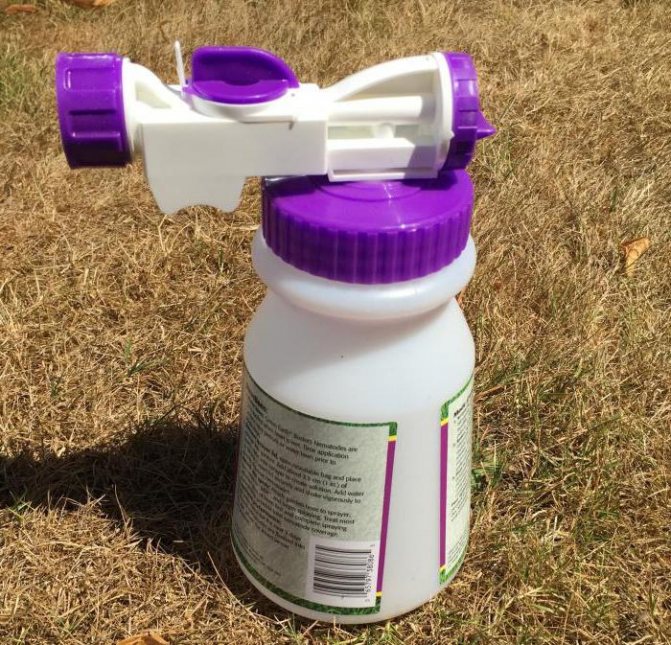

If the beetles are located high on the tree and cannot be removed manually, you can simply spread the film under the crown and shake the crown a couple of times. Just collect the fallen insects and drown them in water or crush them.
Light traps, which are used only at night, are also very effective. It's easy enough to make them. An ordinary lamp is installed in an ordinary glass jar. Since insects usually fly into the light, they hit the walls of the can. You need to put containers with kerosene next to it. After the insect loses orientation, it falls into this vessel and dies in it.
In addition, there are some bird species that feed on these pests. Try to attract magpies, rooks, or jackdaws to your garden. They will quickly deal with these insects.
How to keep an insect at home, how to feed it and how to care for it?
To raise a rhinoceros nest at home, you don't even need to feed it.However, despite the belief that these creatures do not require food, you can offer the new tenant chopped plant food, such as ripe fruit. They do not feel the need for water, they have enough moisture from the fruit pulp.
Larvae and adults require different conditions of detention. In order for a horned pet to feel comfortable and develop correctly, it must be placed in a glass jar or aquarium. A dwelling for him can also be arranged in a box made of thick cardboard. It is recommended to cover the bottom of the house with coconut substrate or moss. The litter should be changed at least once a month. When keeping several rhinoceros beetles, you must be prepared for the fact that you may have to resettle them due to constant fights.
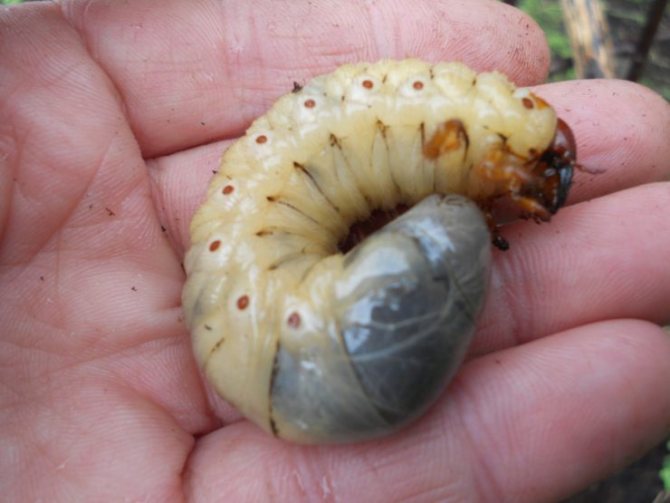

The larvae will need special conditions for development. A cradle for them can be built in a plastic container. At its bottom, it is necessary to lay in layers:
- Peat.
- Wood sawdust. Hamster litter can be used in place of the second layer.
- Wet tea leaves (tea leaves).
- Wood sawdust.
- Flour. The last layer should not be dense. It will take 1-2 tsp. flour.
Loading ...
Meet the enemy in the face
And now we offer to get to know the inhabitants of your kitchen better. Here we have collected photos of the 4 most common types of bugs and links to Wikipedia articles about their features and favorite food.
Below is a photo of the Surinamese muco-eater (Latin name for muco-eater: Oryzaephilus surinamensis). It is difficult to confuse the Surinamese muco-eater with someone because of its sawtooth body.
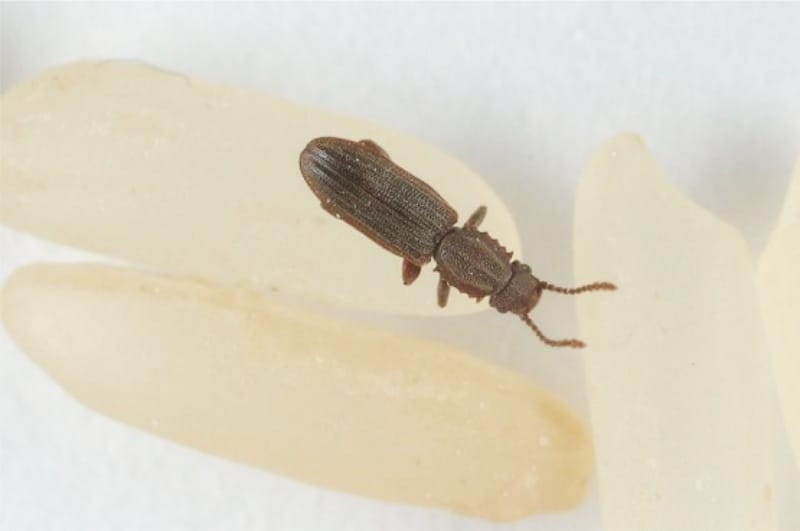

Surinamese mucoed
Next - a photo of the Flour Beetle or Flour Beetle (Latin name: Tenebrio molitor). By the way, mealworms are the larvae of the mealworm.
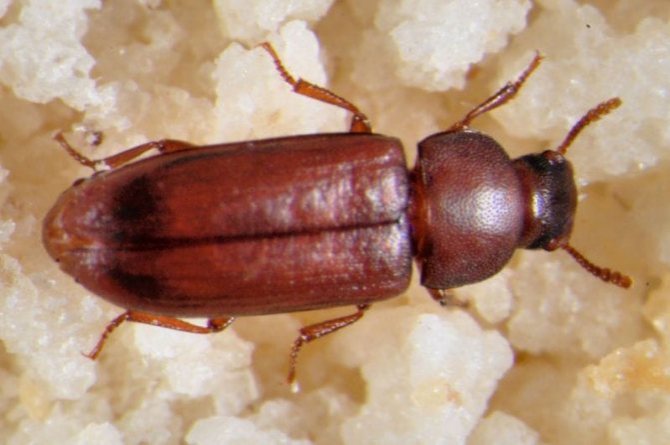

Flour beetle
The next photo shows the Bread Grinder, Kozheed or the Pharmacy Beetle in the company of their own kind (the Latin name of the grinder: Stegobium paniceum).


Bread grinder
And finally, a photo of rice weevils or elephants.
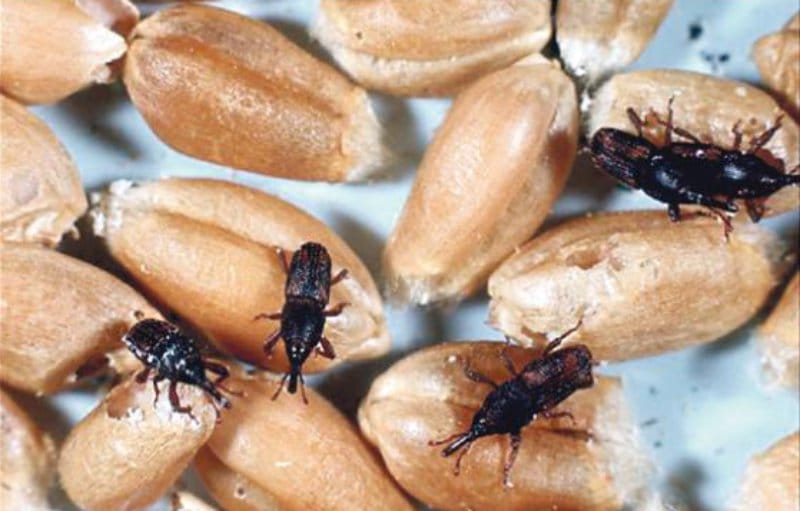

Weevils
Other types
Other types of beetles with chitinous outgrowths on their heads are also called rhinos. Although among them you can often already find not unicorns, but two- and three-horns. Since these individuals look exotic, but do not live long, collectors willingly buy them dried. How much a rhino beetle costs depends on its species and rarity. A common rhinoceros beetle, which is larger than usual, sold for $ 10. But "as if it were alive."
We suggest you familiarize yourself with: What fly bites look like
Relatively common types of rhinos that are easy to buy:
- rhinoceros palm beetle (Oryctes rhinoceros);
- elephant beetle (Megasoma elephas);
- Japanese rhinoceros beetle (Trypoxylus dichotomus);
- Australian rhinoceros beetle (Xylotrupes ulysses).
The palm rhino is similar in appearance to the common hollow rhino. But its larvae are able to feed on living wood, which is presumably why this species is a pest.
The Japanese rhinoceros beetle is a very large insect. Together with the horn, the body length of the male is up to 8.2 cm. The female is up to 4.7 cm. The main horn is directed forward and upward. It has a peculiar shape: initially triangular, the horn flattens towards the end and divides into two processes, which also bifurcate. In addition to the main horn, the Japanese beetle also has another, growing from the middle of the pronotum towards the main one.
The Australian rhino has an original side view: the horn on the nose has a rounded shape that grows backward. From the side of the back, two massive outgrowths are directed towards the main horn. Because of this structure, the head of the Australian rhino looks massive and cuboid. And the horns seem to be an open handle for this box.



